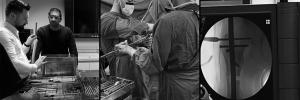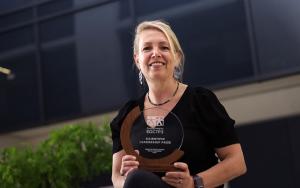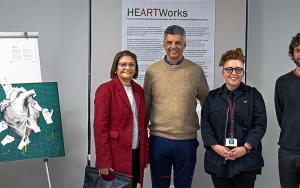
Tygerberg-SU chirurge eerste om nuwe ledemaatrekonstruksie in Suid-Afrika uit te voer
- A team of orthopaedic surgeons at Tygerberg Hospital recently achieved a South African first when they performed an innovative limb reconstruction surgery that has only been done a handful of times in the world.
- The team of surgeons, also affiliated with Stellenbosch University’s Limb Reconstruction Unit, implanted a Fitbone Transport Nail (Fitbone TLN) on a 64-year old former police officer who sustained a gunshot injury to his right femur in 2018.
- The surgical team was headed by Professor Nando Ferreira, Head Clinical Unit: Tumour, Sepsis and Reconstruction, and also included Dr Edward Fuzy, Dr Jayesh Haribhai, and Dr Tino-Vito Orlandi.
A team of orthopaedic surgeons at Tygerberg Hospital recently achieved a South African first when they performed an innovative limb reconstruction surgery that has only been done a handful of times in the world.
The team of surgeons, also affiliated with Stellenbosch University’s Limb Reconstruction Unit, implanted a Fitbone Transport Nail (Fitbone TLN) on a 64-year old former police officer who sustained a gunshot injury to his right femur in 2018. Despite several operations, his injury would not heal, making him an ideal candidate for the surgery.
The surgical team, headed by Professor Nando Ferreira, Head Clinical Unit: Tumour, Sepsis and Reconstruction, was the first-ever implantation of a Fitbone TLN to be done in South Africa. The surgical team also included Dr Edward Fuzy, Dr Jayesh Haribhai, and Dr Tino-Vito Orlandi.
“Fitbone TLN is a new-generation device currently available only under custom order and globally only a few such cases have been performed to date,” said Fuzy. “SU and Tygerberg Hospital were selected as one of a small number of international centres to gain early access to the Fitbone TLN.”
Fuzy explained that the patient had a 50 mm femoral bone defect and 30 mm limb length discrepancy as a result of the gunshot wound he sustained. “In 2018, he had an intramedullary nail – a titanium tube placed inside the femur, which is standard care for femur fractures. But the fracture in his femur would not heal, and in 2020, we did a bone graft. But that didn’t work either.
“Six years after his injury the patient had chronic and worsening pain, and his injured leg was shorter than the other. He was walking with a crutch and had instability in the femur. It left us in quite a predicament with regard to what can be done,” said Fuzy.
They opted for the Fitbone TLN which is the only “all-internal” technology in the world which can treat both bone defects and limb length discrepancy in a single operation.
The technique involves bone transport (gradual movement of healthy bone to fill the defect) while also lengthening the femur to restore equal limb lengths.
Fuzy said the company Orthofix has added a motorised carriage to existing devices used in bone-lengthening operations. “It’s a novel implant to which you fix the piece of bone in the middle - and the transport lengthening nail can lengthen the bone.”
Fuzy, who presented this case in Italy recently, said the treatment requires up to 100 days for the new bone to regenerate and for the leg lengths to equalise. After this, full healing takes another 200 days.
“This transport lengthening nail is the pinnacle of orthopaedic reconstruction surgery. There are possibly between 20 and 30 people across the world who have ever done this operation or have the skills technically to do it. Professor Ferreira is one of those individuals, as one of the pioneering surgeons assisting Orthofix and directly involved in the early adoption and troubleshooting for them,” said Fuzy.
“It’s an all-internal solution for a very difficult problem that, previously, was handled with a cumbersome, difficult, complicated treatment path done externally. The engineering behind it is unbelievable. The fact that we have access to this for our patients in Africa - and that, we at an institution like SU and at Tygerberg Hospital are at the pinnacle of this, is amazing.
Fuzy, who is a clinical fellow under Professor Ferreira, said he was delighted to have been part of the team working on this pioneering surgery. “It’s the end of a long journey to be able to bring this treatment to our patients,” he said.
“For me, as someone relatively new to the world of limb reconstruction, to be part of a dynamic unit at the pinnacle of orthopaedic expertise, has been wonderful. We are doing things here that frequently, people from the United States and Europe, come to us, to see what we are doing in our unit, and to see how this technology can be applied.
“As a South African trained doctor, to see that we are not followers, but leaders, clinically and academically is incredibly exciting.”



